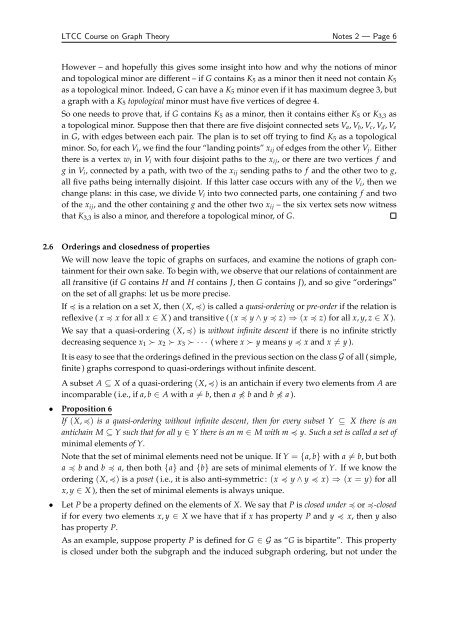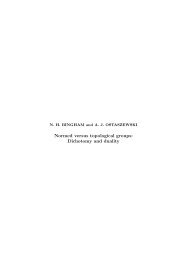LTCC Course on Graph Theory 2010/11 Notes 2 Graphs on ...
LTCC Course on Graph Theory 2010/11 Notes 2 Graphs on ...
LTCC Course on Graph Theory 2010/11 Notes 2 Graphs on ...
Create successful ePaper yourself
Turn your PDF publications into a flip-book with our unique Google optimized e-Paper software.
<str<strong>on</strong>g>LTCC</str<strong>on</strong>g> <str<strong>on</strong>g>Course</str<strong>on</strong>g> <strong>on</strong> <strong>Graph</strong> <strong>Theory</strong> <strong>Notes</strong> 2 — Page 6<br />
However – and hopefully this gives some insight into how and why the noti<strong>on</strong>s of minor<br />
and topological minor are different – if G c<strong>on</strong>tains K 5 as a minor then it need not c<strong>on</strong>tain K 5<br />
as a topological minor. Indeed, G can have a K 5 minor even if it has maximum degree 3, but<br />
a graph with a K 5 topological minor must have five vertices of degree 4.<br />
So <strong>on</strong>e needs to prove that, if G c<strong>on</strong>tains K 5 as a minor, then it c<strong>on</strong>tains either K 5 or K 3,3 as<br />
a topological minor. Suppose then that there are five disjoint c<strong>on</strong>nected sets V a , V b , V c , V d , V e<br />
in G, with edges between each pair. The plan is to set off trying to find K 5 as a topological<br />
minor. So, for each V i , we find the four “landing points” x ij of edges from the other V j . Either<br />
there is a vertex w i in V i with four disjoint paths to the x ij , or there are two vertices f and<br />
g in V i , c<strong>on</strong>nected by a path, with two of the x ij sending paths to f and the other two to g,<br />
all five paths being internally disjoint. If this latter case occurs with any of the V i , then we<br />
change plans: in this case, we divide V i into two c<strong>on</strong>nected parts, <strong>on</strong>e c<strong>on</strong>taining f and two<br />
of the x ij , and the other c<strong>on</strong>taining g and the other two x ij – the six vertex sets now witness<br />
that K 3,3 is also a minor, and therefore a topological minor, of G.<br />
2.6 Orderings and closedness of properties<br />
We will now leave the topic of graphs <strong>on</strong> surfaces, and examine the noti<strong>on</strong>s of graph c<strong>on</strong>tainment<br />
for their own sake. To begin with, we observe that our relati<strong>on</strong>s of c<strong>on</strong>tainment are<br />
all transitive (if G c<strong>on</strong>tains H and H c<strong>on</strong>tains J, then G c<strong>on</strong>tains J), and so give “orderings”<br />
<strong>on</strong> the set of all graphs: let us be more precise.<br />
If is a relati<strong>on</strong> <strong>on</strong> a set X, then (X, ) is called a quasi-ordering or pre-order if the relati<strong>on</strong> is<br />
reflexive ( x x for all x ∈ X ) and transitive ( (x y ∧ y z) ⇒ (x z) for all x, y, z ∈ X ).<br />
We say that a quasi-ordering (X, ) is without infinite descent if there is no infinite strictly<br />
decreasing sequence x 1 ≻ x 2 ≻ x 3 ≻ · · · ( where x ≻ y means y x and x ̸= y ).<br />
It is easy to see that the orderings defined in the previous secti<strong>on</strong> <strong>on</strong> the class G of all ( simple,<br />
finite ) graphs corresp<strong>on</strong>d to quasi-orderings without infinite descent.<br />
A subset A ⊆ X of a quasi-ordering (X, ) is an antichain if every two elements from A are<br />
incomparable ( i.e., if a, b ∈ A with a ̸= b, then a ̸ b and b ̸ a ).<br />
• Propositi<strong>on</strong> 6<br />
If (X, ) is a quasi-ordering without infinite descent, then for every subset Y ⊆ X there is an<br />
antichain M ⊆ Y such that for all y ∈ Y there is an m ∈ M with m y. Such a set is called a set of<br />
minimal elements of Y.<br />
Note that the set of minimal elements need not be unique. If Y = {a, b} with a ̸= b, but both<br />
a b and b a, then both {a} and {b} are sets of minimal elements of Y. If we know the<br />
ordering (X, ) is a poset ( i.e., it is also anti-symmetric : (x y ∧ y x) ⇒ (x = y) for all<br />
x, y ∈ X ), then the set of minimal elements is always unique.<br />
• Let P be a property defined <strong>on</strong> the elements of X. We say that P is closed under or -closed<br />
if for every two elements x, y ∈ X we have that if x has property P and y x, then y also<br />
has property P.<br />
As an example, suppose property P is defined for G ∈ G as “G is bipartite”. This property<br />
is closed under both the subgraph and the induced subgraph ordering, but not under the
















